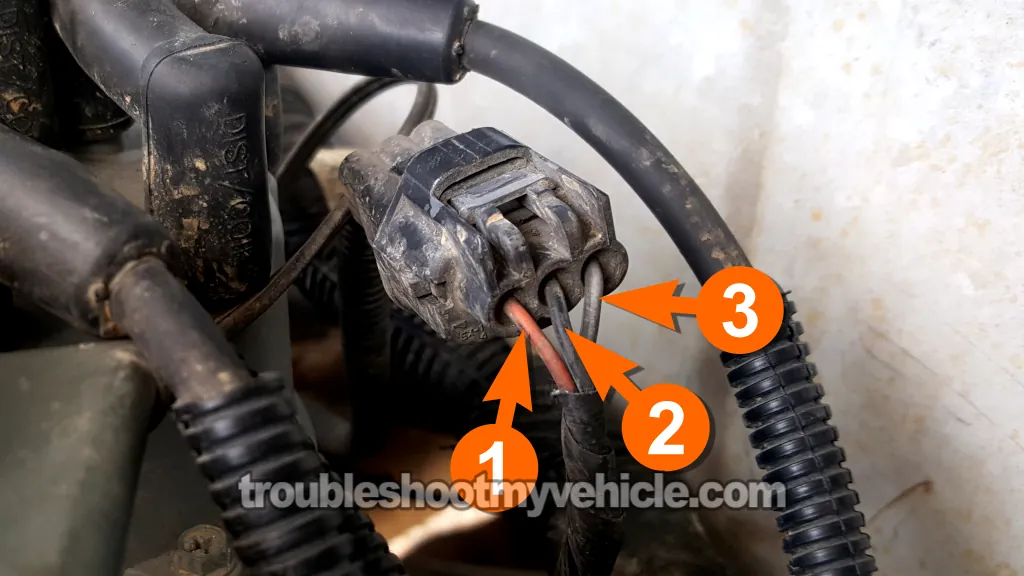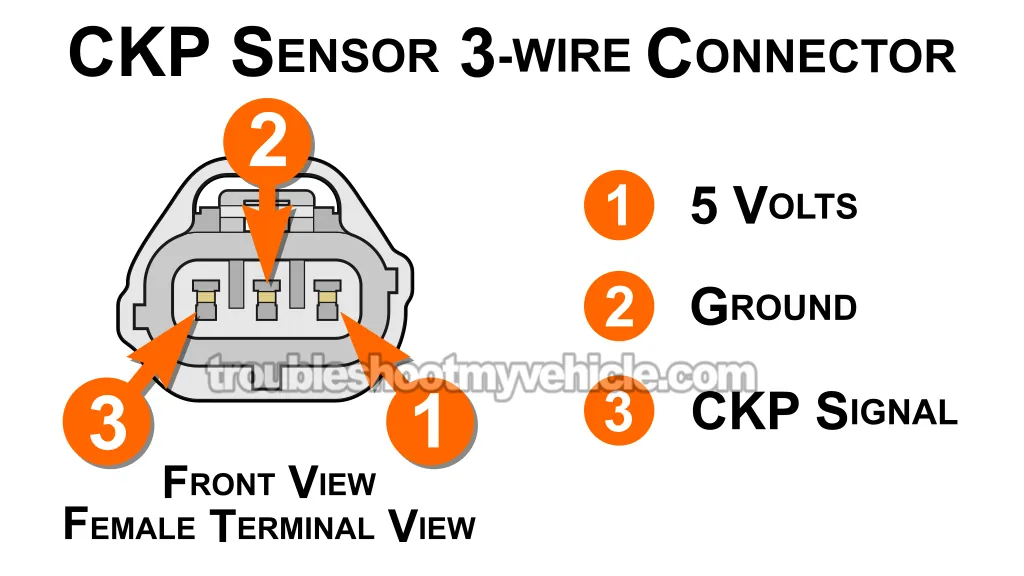
The crankshaft position (CKP) sensor sits right on the transmission bell housing, and the good news is —it's not hard to test.
Since the CKP sensor is a 3-wire Hall-Effect type, it can easily be checked with a regular multimeter -no need for a scan tool or any other expensive testing equipment!
In this tutorial, I'll walk you through each test step-by-step. By the end of your tests, you'll know for sure if the CKP sensor's dead and behind your Dodge Ram's no-start issue.
Contents of this tutorial:
- Important Tips And Suggestions.
- How The CKP Sensor Works.
- CKP Sensor Connector Pinout.
- Where To Buy The CKP Sensor And Save.
- TEST 1: Checking The CKP Signal With A Multimeter.
- TEST 2: Making Sure The CKP Sensor Has Power.
- TEST 3: Making Sure The CKP Sensor Has Ground.
- More 3.9L V6 Dodge Ram Pickup Tutorials.
APPLIES TO: This tutorial applies to the following vehicles:
- 3.9L V6 Dodge Ram 1500 Pickup: 1998, 1999, 2000, 2001.
- 3.9L V6 Dodge Ram 2500 Pickup: 1998, 1999, 2000, 2001.
WIRING DIAGRAMS:
- Ignition System Wiring Diagram (1998-2000 3.9L V6 Dodge Ram Pickup).
- Ignition System Wiring Diagram (2001 3.9L V6 Dodge Ram Pickup).
IGNITION SYSTEM TESTS:
- How To Test The Ignition Coil (1992-2001 3.9L V6 Dodge Ram Pickup).
- How To Test The Camshaft Position Sensor (1998-2001 3.9L V6 Dodge Ram Pickup).
Important Tips And Suggestions
TIP 1 → On-Car Test: We're gonna test the CKP sensor while it's still bolted onto the bell housing. It's important that you don't remove it (to test it).
TIP 2 → Turn the engine by hand (not using the starter): The only way to get a clean, reliable voltage reading on your multimeter is by slowly cranking the engine by hand.
This part really matters —if you crank the engine using the starter, you won't be able to see the CKP signal voltage pulses with your multimeter.
By "turning it by hand", I mean grabbing a 1/2-inch ratchet and the correct socket so you can manually rotate the crankshaft pulley.
TIP 3 → Always test for spark first: If you already checked for spark and the ignition coil is sparking away, that means the CKP sensor's working.
If you haven't checked for spark, this tutorial will help you:
How The CKP Sensor Works

The crankshaft position sensor (CKP) is mounted right on the bell housing of the transmission. From that spot, it watches the flywheel's notches (slots) as the engine turns over or runs. Let's break it down a little more:
- CKP signal: The flywheel has 6 notch groups arranged evenly around its outer edge —3 single-notch sets and 3 double-notch sets. As each group moves past the CKP sensor, it sends a signal to the computer:
- Each single notch produces one pulse.
- Each double notch (a pair of notches close together) creates two back-to-back pulses.
- Purpose: These pulses help the engine control module figure out the crankshaft's exact position and RPM. That info gets combined with the camshaft sensor (CMP) data to precisely time ignition and fuel delivery.
- No CKP signal, no-start: If the CKP signal doesn't reach the computer, it shuts off the Auto Shutdown (ASD) relay and the fuel pump relay. That cuts off power to both the ignition coil and injectors —and the engine won't start.
- ON/OFF voltage: As the crankshaft spins, the CKP sensor flips between ON and OFF states. You'll see 5 Volts DC when it's ON and 0 Volts when it's OFF.
- A single-notch set causes one clean voltage change.
- A double-notch set causes two quick voltage flips, one after the other.
- Testing: Here's the good part —you can actually watch these voltage changes happen using an ordinary multimeter (if you turn the engine over manually). That's exactly what we'll be doing in the test steps.
CKP Sensor Connector Pinout

| Pin | Wire Color | Description |
|---|---|---|
| 1 | Violet with white stripe (VIO/WHT) | 5 Volts DC |
| 2 | Black with light blue stripe (BLK/LT BLU) | Sensor Ground |
| 3 | Grey with black stripe (GRY/BLK) | CKP Signal |
Where To Buy The CKP Sensor And Save
If you're unsure whether the CKP sensor above fits your exact vehicle, don't worry. When you get to the site, they'll double-check the fit for you by asking for your Dodge Ram pickup's details. If it doesn't fit, they'll help you get the right one.
TEST 1: Checking The CKP Signal With A Multimeter
To our CKP sensor diagnostic under way, we're gonna see if it's actually putting out an ON/OFF signal through its signal wire.
The CKP signal wire is the gray with black stripe (GRY/BLK) wire coming out of the CKP sensor's engine wiring harness connector.
Since the sensor has to stay plugged in for this test to work, you'll need to tap into that GRY/BLK wire directly.
There are two ways to do it:
- You can either back-probe the connector.
- Or use a wire-piercing tool.
Here's a closer look at wiring piercing probe and where to get it: Wire Piercing Probe Tool Review (Power Probe PWPPPPP01).
IMPORTANT: Like I said earlier, don't remove the CKP sensor for this test. If you pull the sensor out and reinstall it, the sensor's air gap calibration will be lost and the flywheel's reluctor ring will smack right into it and destroy it.
NOTE: Need to buy a multimeter or an upgrade? This is the one I have and use: Tekpower TP8268 AC/DC Auto/Manual Range Digital Multimeter (at: amazon.com).
Alright, let's get started:
- 1
Disconnect the ignition coil from its harness connector. This is a crucial safety step —don't skip it before moving forward.
- 2
Clip the black multimeter lead to the battery's negative (-) terminal.
- 3
Turn the key to the ON position (but don't start the engine). This powers up the CKP sensor and gets it ready for testing.
- 4
Find the CKP sensor connector.
Once you've located it, peel off any wire loom or tape that's covering the sensor wires. You only need enough space to tap into the wire for the CKP signal test.
NOTE: Double-check that you're working with the right connector. The CKP and CMP sensor connectors are almost identical. The one you need goes to the sensor mounted on the transmission bell housing —not the one inside the distributor. - 5
Set your multimeter to DC Volts mode.
- 6
Connect the red multimeter lead to the GRY/BLK wire on the CKP harness connector.
That's the wire going to terminal number 3 —just like the diagram shows above.
NOTE: You've gotta leave the CKP sensor plugged in while running this test. - 7
Have someone slowly turn the crankshaft pulley by hand (clockwise) while you keep an eye on the meter.
NOTE: Only use hand-cranking here —the starter motor will turn the engine over too fast and you're not gonna be able to see the ON/OFF voltage changes. - 8
Watch for the voltage to toggle between 0 and 5 Volts DC as the crank pulley turns.
OFF means 0 Volts. ON means 5 Volts. Have your helper turn the crank nice and steady so you can catch the voltage changes.
NOTE: You should catch a total of 6 sets of voltage flips for each full rotation of the crankshaft: 3 single flips and 3 double flips.
→ A single flip happens when a single notch on the flywheel passes under the sensor and you'll see the voltage jump once (from 0 to 5 or vice versa).
→ A double flip happens when a pair of notches (double notch set) passes by —you'll see the voltage flip twice in quick succession.
Now let's break down what your results tell you:
CASE 1: You saw the multimeter switch back and forth between ON and OFF (5V and 0V). That's exactly what you want —your CKP sensor's working like it should.
Since the sensor's fine, you'll need to keep digging for the real cause of the engine's no-start problem. Your next move should be to test the CMP sensor:
CASE 2: You didn't see the multimeter change at all while turning the crank by hand. That tells you the CKP sensor isn't sending a signal —and the PCM needs that signal to fire spark and inject fuel.
In most cases, this means the CKP sensor has failed. Replacing it usually solves the problem and gets the engine going again.
Before throwing in a new one, make sure the sensor's actually getting its power supply (5 Volts from the PCM). Your next test is here: TEST 2: Making Sure The CKP Sensor Has Power.



